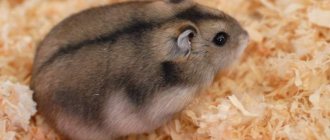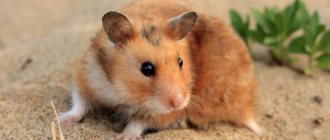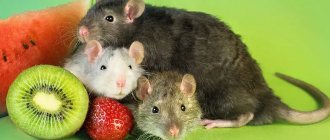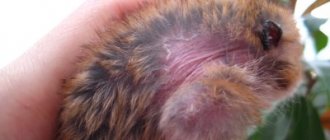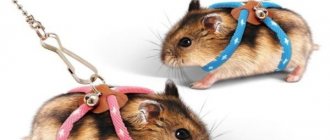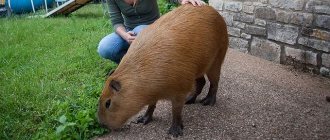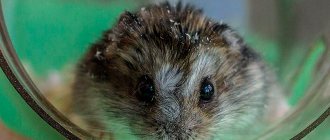If your baby has expressed a persistent desire to have a pet, then it is better to choose a small pet, for example, a rodent. Before purchasing, you should study information about which hamster is best to get, how to arrange its home, how to make it tame and how to care for it.
Don't forget to consult with your children about what color and size animal they want.
It is best to buy a hamster at a pet store, because its employees will tell you about the characteristics of the breed and the rules of care. But not everyone has this opportunity, so this article will discuss which hamster is best to buy so that it becomes a favorite for the whole family.
Which hamster is better to get: characteristics of popular species
Today, many breeds of the rodents in question are known, but not all of them can be kept at home and allowed near children. Despite their small size, hamsters can be quite aggressive. In addition, they can in some cases cause allergies. Therefore, before buying a hamster, it is advisable to borrow an animal from friends for a few days and check the reaction of the family members.
The most popular rodents that can be kept at home include the following breeds:
- Djungarian is a common species. They have gray fur with a dark stripe on the spine and are classified as dwarf because they do not grow more than ten centimeters. Compared to other breeds, they are best tamed, but due to their small size, it is better not to have them in homes with children of kindergarten age - the nimble animal can slip out of children’s hands and get injured. Suitable for children from 10 years old.
- The Campbell breed looks practical in appearance, like the Djungarian, but their character is quite capricious and they bite. Individuals have a more yellow color and a paler stripe on the back.
- Roborovsky's hamsters are one of the smallest and rarest representatives (adult animals are no larger than 6 cm). A characteristic difference is socialization; they get along with same-sex relatives in the same cage. Kids will have fun watching a bunch of rodents, but they are unlikely to be able to pick them up - they are shy.
- Among Syrian hamsters, the royal hamster is the largest representative of the breed. Adults can be compared in size to a guinea pig. A distinctive feature is that they respond to the sound of their nickname. They are quite hardy in terms of physical health and life expectancy is 3–4 years. If you want to get a rodent for your home, then choose them, but remember - if handled roughly, they will show retaliatory aggression. The coat has different lengths - Angora with long hair and short-haired. Color - from golden to black. The only inconvenience is that they need a large cage. A 7-9 year old child can handle this animal on his own.
- The grasshopper (scorpion) hamster is a wild predator that eats even lizards or scorpions, and is solitary by nature. Therefore, zoologists do not recommend purchasing it for children.
- Siberian (White Russian Dwarf). It differs in that it changes the color of its coat depending on the time of year. It grows up to 10 centimeters and gets along well with people and is friendly.
- Eversmann's hamster is a wild field animal reaching a length of 16 centimeters. It is extremely rare in captivity and is asocial, so it should not be given to children.
Red-eyed albinos are found in every breed. You should not be afraid of them - the unusual color is explained by genetic changes. Such animals are healthy and no different from other “colored” relatives.
What to feed hamsters at home?
Rodents in nature have learned to survive by eating both grain foods and animal products. They subconsciously avoid harmful plants or poisonous insects, avoiding poisoning. In apartments, pet owners are tempted to give their little ones pieces of food from the table in order to please the pet, which sometimes causes irreparable harm to them. When asking what you can feed hamsters at home, be careful; it is advisable to know exactly the foods prohibited for these animals.
Plant foods allowed for hamsters:
- ready-made dry diets for hamsters,
- sprouted grains of oats, wheat, other cereals,
- different types of nuts (hazelnuts, walnuts, peanuts),
- sunflower and pumpkin seeds,
- cherries, gooseberries, blueberries, other berries,
- pieces of vegetables processed in boiling water without salt,
- raw vegetables and fruits,
- peas in pods or grains,
- a small amount of rose hips and celery,
- Jerusalem artichoke fruits,
- dried fruits,
- branches of deciduous trees,
- greenery.
Allowed animal products:
- fermented milk products (cheese, cottage cheese, unsweetened yogurt) with a fat content of up to 1%,
- boiled chicken meat without spices,
- boiled eggs,
- boiled low-fat fish,
- in rare cases, pieces of peeled shrimp,
- worms and insects purchased from pet stores.
Domestic hamsters can easily tolerate care and maintenance at home, but for them there is an extensive list of prohibited foods:
- potato,
- fatty cheeses,
- ready-made bird feed,
- fresh bread,
- acorns,
- red beans,
- brazil nuts,
- any spices,
- fresh milk,
- garlic with onions,
- cabbage causes gas in hamsters,
- muesli,
- fried food,
- tropical fruits,
- honey,
- mushrooms,
- sweet cookies,
- wild-caught insects and bloodworms,
- tulip bulbs,
- chocolates,
- ice cream.
Boy or girl? Character traits
If you don’t know what kind of rodent to get so that it gets along with kids, pay attention to gender. Unlike rats or other small pets, hamsters are not sterilized, so due to hormonal characteristics, the character and behavior of a male or female differs.
- Boys are larger than girls, they are calmer, more patient and affectionate, but they “mark” their territory, so an unpleasant odor if their home is not cleaned in a timely manner is guaranteed.
- Hamsters are more mobile and active, but at the same time they are also “hot-tempered”, especially during pregnancy or immediately after birth. They can injure the male, so they should be removed immediately after fertilization. In addition, females sometimes experience health problems related to the reproductive organs (endometritis).
Character, size, habits - all this can influence which hamster is best for a child.
Habitat
The hamster will delight with its presence and will not cause problems for the owners if you make sure that the habitat is completely suitable for the animal.
Caring for a hamster at home is easy if you immediately buy a house for it and equip it with everything you need.
The cage should be spacious enough. When purchasing, pay attention to the location of the rods. They should be placed horizontally so that the hamster feels free at home and can climb the walls to any height.
The minimum dimensions are 30x50 cm, height 25 cm. If the cage is larger, the pet will only be happy with it.
Instructions for caring for hamsters include the correct choice of location for the cage:
- comfortable room temperature for the animal is from 20 to 24 degrees;
- direct sunlight should not fall on the cage;
- It is unacceptable to place the animal near heating boilers and radiators;
- it is dangerous to place the house in a draft;
- noise from TV and other devices should not disturb the pet;
- the cage must be positioned so that small children and pets cannot reach it;
- the room should be easily ventilated.
When choosing a place for the animal, you need to take into account that younger family members can also care for the hamster. Another feature: the rodent likes to sleep during the day, and at night it becomes active and makes noise.
Sometimes they get out of the situation and place the hamster in an aquarium or a three-liter jar. An aquarium (without water) can be adapted if it is spacious, which cannot be said about a jar. For a rodent, such housing can only be used while the cage is being cleaned.
How to choose a hamster for a child: general tips
Hamsters are sold at any bird market. A large number of animals in one place causes the spread of infectious diseases and parasites. A cage standing in frost or draft leads to colds and hypothermia. Therefore, preference should be given to specialized stores where animals receive proper care.
The rodents in question are active at night, so to choose a healthy hamster, you should go to the pet store in the evening. A healthy rodent actively moves around the cage, runs on a wheel, digs in food and bedding, and does not limp. When a hamster is not sleeping, it should not show apathy or freeze in a stupor.
Pay attention to the age of the fluffy. Cubs up to a month old require special care - they need to be provided with enhanced heating and nutrition with special mixtures from a pipette.
After three months, the animal already has formed habits and is difficult to train. Therefore, the optimal age for choosing Syrian or other hamsters is 1 or 2 months.
Conduct a self-examination of the rodent. Take him in your arms - there should be no bald spots or lumps on the body. Signs of a health condition are:
- Smooth and shiny skin without bald spots.
- No nasal or eye discharge.
- Active behavior without obvious signs of overexcitation.
Yellow teeth are normal. This is explained by the characteristics of animal tooth enamel.
Features of caring for pet hamsters
Like most other animals, pet hamsters can be stressed. As a rule, their causes may be the following circumstances:
- changes in the animal's daily routine;
- lack of water;
- external control over his offspring;
- the presence of lighting in the cage where he sleeps;
- introducing another animal, even a hamster.
Also, in order to prevent stressful situations for your hamster, do not talk loudly or scream when near his cage, do not make any sudden movements in this place so that the animal does not feel danger. If you speak to your hamster quietly and calmly, he will behave accordingly.
Also consider the following tips for caring for pet hamsters:
- The hamster must be moved to another cage using a special tube. First he is nudged by hand so that he can explore a new place;
- You need to care for your hamster's teeth carefully and on an ongoing basis. If he eats food that is not too solid, then his teeth grow very quickly , and this interferes with normal food intake;
- The cage should be cleaned several times during the week. During cleaning, the hamster is pulled out of the house and transferred to another place, for example, into a prepared jar. The bedding is changed and the cage is washed with detergent. The toilet area should be cleaned regularly as it gets dirty;
- The hamster needs to be walked regularly. For this purpose, a special playing place will be equipped. You can make obstacle courses, mazes and something similar. At the same time, all sharp objects must be removed from the resting place, and nearby pieces of furniture and decor must be as durable as possible in terms of stability;
- You need to regularly monitor the animal’s claws, especially if it has reached a certain age. Nails are trimmed using special manicure scissors. Do not use a nail file; your hamster may get scared and hurt himself. If the pigmentation of the hamster's claws is weak, they are trimmed only in daylight or table light. If injured, during this procedure, the paw is wrapped with a bandage, and the cage itself is washed so that the wound does not become infected;
- Hamsters do not like water very much, so bathing unless necessary is not recommended. But if you still need to bathe the hamster, be careful not to let water get into its ears, eyes or nose. Don't let the hamster out of your hands so that he doesn't bite you. You need to bathe the animal only if it is very dirty, using rabbit shampoo for this purpose. After bathing, hold your hamster in your hands for a while to warm it up, and then wrap it in a soft towel.
What else should you consider when keeping a hamster in your home?
To keep your hamster calm and not experience stressful situations, remember the following:
- house him separately from other hamsters;
- provide the hamster with peace and quiet;
- You should not show your hamster other pets;
- clean your hamster's house when he doesn't see it;
- do not interfere with his lifestyle;
- never punish hamsters;
- do not take it outside or let it on the grass; direct sunlight is especially dangerous for it; it can die in just a few minutes.
If you plan to not only keep, but also breed hamsters at home, then this will not be too difficult. They are capable of producing regular offspring and independently feed up to ten broods throughout the year. To do this, the mother hamster needs to create appropriate conditions - ensure peace and not be taken out of the cage during pregnancy.
As you can see, keeping pet hamsters in an apartment is not so difficult. If all necessary conditions of maintenance and care are observed, this animal will delight you and especially your children for a long time, who will play with hamsters with great pleasure.


